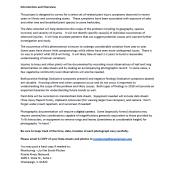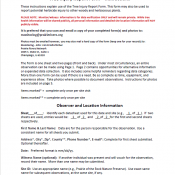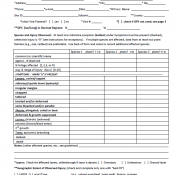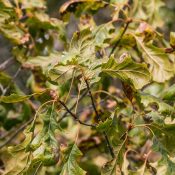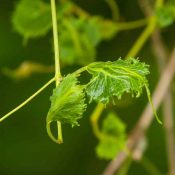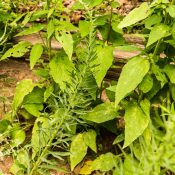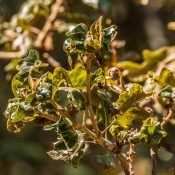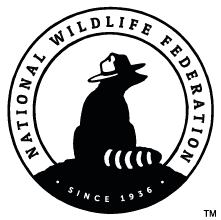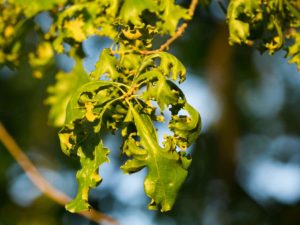 Prairie Rivers Network is concerned with the steady declines in state and federal monitoring programs and how the resulting decreases in ecological data limit our ability to monitor the health of ecosystems under the pressures of habitat loss, pesticides, and climate change. In recent years, PRN and numerous partners have received an increase in reports of plant and tree injury on both public and private lands. These injuries are symptomatic of herbicide exposure and may be due to drift and/or volatility.
Prairie Rivers Network is concerned with the steady declines in state and federal monitoring programs and how the resulting decreases in ecological data limit our ability to monitor the health of ecosystems under the pressures of habitat loss, pesticides, and climate change. In recent years, PRN and numerous partners have received an increase in reports of plant and tree injury on both public and private lands. These injuries are symptomatic of herbicide exposure and may be due to drift and/or volatility.
The growing season is in full swing and people are already seeing signs of potential herbicide damage. If you notice herbicide injury on your plantings or on non-target species you can report it to the Illinois Department of Agriculture at “Pesticides: Uses & Misuses,”
Also, call IDOA’s Bureau of Environmental Programs at 1-800-641-3934 (voice and TDD) or 217-785-2427 for a complaint form. Complaints must be received by the IDOA within 30 days of the incident or within 30 days of when the damage was first noticed. Complaints filed after that will be kept on record, but no administrative action can be taken.
These materials are here on our website. By helping us keep track of potential herbicide damage to non-target species you will be helping increase the “eyes on the trees and boots on the ground” and drastically improve our ability to document injury to species on a statewide level.
Below are volunteer guidelines, monitoring instructions, and a data recording form. For the time being, all data will be housed at PRN but will be publicly available at the end of the monitoring season. Private information will not be shared publicly and is for the sole purpose of data verification.
We thank you for your assistance in keeping an eye out for the biodiversity of Illinois and we welcome your feedback. Please email feedback and monitoring forms and photos to monitoring@prairierivers.org.
Leaf Symptoms
Note to the user: Most symptom photos will have more than one symptom demonstrated on a leaf. For example, MANY will show leaf cupping/curling in addition to the symptom of focus for a particular category. Nature often rarely presents leaves with more than one symptom. Please click a box to see examples of injury.
Normal Leaves
 These are examples of normal leaf growth from varying species.
These are examples of normal leaf growth from varying species.
Curled/Cupped
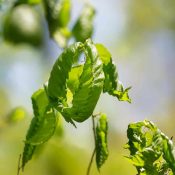 Curling of leaf margins or cupping of entire leaf. Leaf edges may bend up or down, or in more severe cases, the entire whole leaf is curled up or more commonly downward. The latter creates a “boxing-glove” like look in oaks. Both may be accompanied by discoloration at the margin (e.g., yellowish or grayish). As injury intensifies, edges may turn brown or black. In either case, the color change may also be noted as a symptom (see Chlorosis and Necrosis description below).
Curling of leaf margins or cupping of entire leaf. Leaf edges may bend up or down, or in more severe cases, the entire whole leaf is curled up or more commonly downward. The latter creates a “boxing-glove” like look in oaks. Both may be accompanied by discoloration at the margin (e.g., yellowish or grayish). As injury intensifies, edges may turn brown or black. In either case, the color change may also be noted as a symptom (see Chlorosis and Necrosis description below).
Epinasty
Twisting of leaf petioles orienting leaves sideways or upside down. This is relatively easy to spot when lower leaf surfaces are colored differently than the upper surface.
Strapped
Leaf blade is unnaturally lengthened or “stretched” in relation to width. It can be accompanied by twisting of the blade surface. It is not necessary to record twisting with strapping.
Twisted and/or Deformed
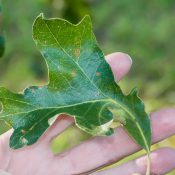 More or less normally proportioned leaf blade is twisted, has an irregular surface, and/or is irregularly lobed.
More or less normally proportioned leaf blade is twisted, has an irregular surface, and/or is irregularly lobed.
Irregular Margins
Abnormal wavy, “crinkled,” or “scallop shell-like” margin (e.g., in redbud or dogwood); or veins at margins may protrude as distinctive points (e.g., in wild grape).
Shoot Symptoms
Elongated, Coiled, or Bent
Pronounced shoot elongation with bending or coiling, typically only seen in spring in developing shoots. It is often accompanied by leaf abnormalities.
Deformed and Growth Suppressed
Overall suppression of shoot elongation and stunting of leaf growth. Generally, leaves will show one or more symptoms such as chlorosis (e.g., box elder) or twisting and deformation (oak).
Additional symptoms: Leaves
Chlorotic
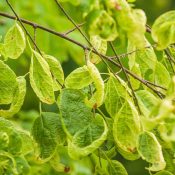 Abnormal light green, yellow, gray, or white coloration of leaves. Many newly emerging leaves are these colors or orange or red before turning a deeper green. Unless experienced, rate chlorosis only on mature or near mature leaves. It may be at edges or entire leaf.
Abnormal light green, yellow, gray, or white coloration of leaves. Many newly emerging leaves are these colors or orange or red before turning a deeper green. Unless experienced, rate chlorosis only on mature or near mature leaves. It may be at edges or entire leaf.
Necrotic
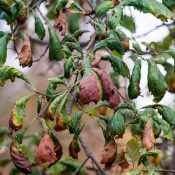 Brown or black tissue indicating tissue death, usually developing at leaf edge and proceeding inward.
Brown or black tissue indicating tissue death, usually developing at leaf edge and proceeding inward.
Second Growth
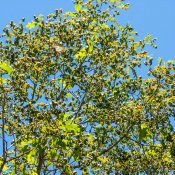 Especially for oaks, if there is obvious leaf damage, check to see whether there is new leaf growth at twig end that appears to have emerged after the 1st spring growth.
Especially for oaks, if there is obvious leaf damage, check to see whether there is new leaf growth at twig end that appears to have emerged after the 1st spring growth.
Additional symptoms: Trees
Death
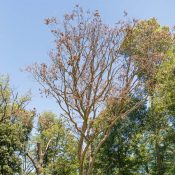 Refers to whole tree death. Rate only for trees which clearly leafed out in the current growing season and then died. Observe leaves for any remaining potential injury symptoms.
Refers to whole tree death. Rate only for trees which clearly leafed out in the current growing season and then died. Observe leaves for any remaining potential injury symptoms.
Dieback
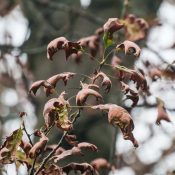 Refers to branches dying usually from ends inward. In severe cases, whole limbs may dieback. As for death, rate as present only if the dead portion clearly leafed out in the current growing season and then died. Otherwise, die-back may indicate damage from previous growing season(s).
Refers to branches dying usually from ends inward. In severe cases, whole limbs may dieback. As for death, rate as present only if the dead portion clearly leafed out in the current growing season and then died. Otherwise, die-back may indicate damage from previous growing season(s).
Epicormic branching
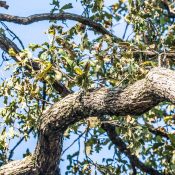 Occurs when twig growth (sometimes dense) occurs on larger branches or main trunks, often seen when dieback of branches is occurring. May also indicate damage from previous growing season(s).
Occurs when twig growth (sometimes dense) occurs on larger branches or main trunks, often seen when dieback of branches is occurring. May also indicate damage from previous growing season(s).

